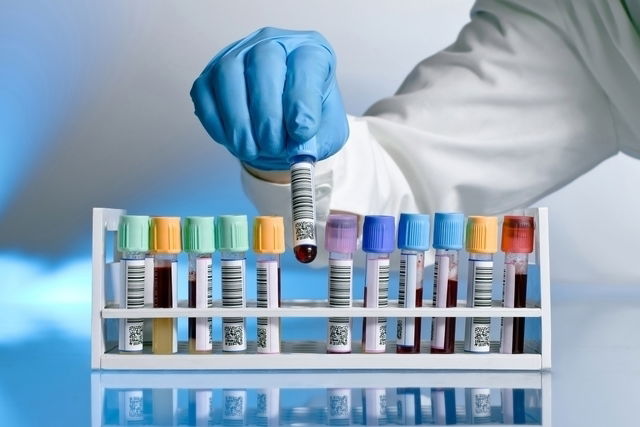AST and ALT, which are also known as transaminases, are two hepatic enzymes that are usually measured in the blood to assess liver health and functioning.
AST, also known as aspartate aminotransferase is stored in the hepatic cells of the liver, but is produced by other tissues like the heart and muscles. Therefore, when there is an increase only in the AST levels, it is usually related to other conditions not linked to the liver.
On the other hand, ALT, known as alanine aminotransferase, is produced exclusively in the liver and therefore when there is an increase in ALT levels, it normally indicates that there may be an alteration in the liver.

Normal AST and ALT levels
AST and ALT values can vary according to the laboratory references, however, the levels that are considered normal are:
- AST: 5 to 40 U/L;
- ALT: 7 to 56 U/L.
Even though AST and ALT are considered liver markers, these enzymes can also be produced by other organs. Therefore, it’s important that the doctor who ordered the test, to confer these results with other lab values and a formal assessment to determine a diagnosis.
What results mean
Abnormal AST and ALT can be above or below the normal reference ranges. The main causes are outlined below:
1. High AST and ALT
High Ast and ALT that are significantly above the normal ranges are usually a sign of liver damage caused by:
- Acute or chronic hepatitis, or alcoholic hepatitis
- Fulminant hepatitis or ischemic hepatitis
- Cirrhosis due to alcohol abuse
- Fatty liver or presence of liver abscess
- Liver tumor
- Hemochromatosis or alpha-1-antitrypsin deficiency
- Bile duct obstruction
- Wilson's disease or Budd-Chiari syndrome.
In addition, high AST and ALT may also indicate other conditions, such as muscle damage, stroke, celiac disease or acute pancreatitis. It can also be caused by drug abusive use and prolonged or inappropriate use of medication
AST and ALT may also be high in the cases of severe pre-eclampsia, eclampsia or HELLP syndrome, due to decreased blood flow to the liver and damage to this organ.
In addition to evaluating AST and ALT levels, the doctor will also calculate the De Ritis ratio. This helps to confirm the extent of liver damage and its extent. A De Ritis ratio greater than 1 is indicative of severe liver damage and treatment should be started as soon as possible to prevent disease progression.
2. Low AST and ALT
Low AST and ALT may indicate problems in the kidneys, like urinary infection or acute kidney injury.
In addition to evaluating AST and ALT, the doctor should order other tests that evaluate the kidneys, such as an R&M urine test, blood work that checks creatinine, urea, sodium or potassium levels, as well as imaging tests, like an ultrasound or MRI.
Also recommended: Creatinine: What Is It, Normal Levels & When to Worry tuasaude.com/en/creatinine3. Only AST is abnormal
When only the AST level is abnormal, it is possible that cardiac problems may be occurring. AST can also be used as a cardiac marker, and abnormal results may be a sign of a heart attack, heart failure or cardiac ischemia.
In these cases, the doctor may order further testing to assess heart health, such as measuring troponin, myoglobin and creatine phosphokinase (CK).
4. Only ALT is abnormal
Abnormal ALT levels, especially when the levels are low, is generally not a cause for concern. This can be a normal finding if the patient does not resent with symptoms.
However, some conditions that can cause low ALT levels include vitamin B6 deficiency, taking hormonal medications, smoking or exercising.
On the contrary, high ALT levels may indicate liver problems. Learn more about the ALT blood test and what high levels can mean.
Medications that can alter ALT or AST
Some medications can change ALT and AST levels in the blood, as they can be associated with side effects such as liver. Medications that can alter liver function and ALT/AST levels include:
- Painkillers, such as acetaminophen;
- Anti-inflammatories, such as nimesulide or acetylsalicylic acid
- Anabolic steroids
- Oral contraceptives
- Antibiotics, such as erythromycin, ciprofloxacin, sulfamethoxazole + trimethoprim, amoxicillin + clavulanate, or isoniazid
- Antiarrhythmics, such as amiodarone
- High cholesterol medications, such as statins
- Antiepileptics, such as valproic acid or phenytoin
- Antifungals, such as ketoconazole or terbinafine
- Chemotherapy drugs, such as methotrexate, asparaginase, imatinib or Pazopanib
- Medicinal plants such as comfrey, cascara or Kava kava
These medications can interfere with ALT and AST levels because most medcatiions, supplements or medicinal plants are metabolized by the liver to be eliminated.
When medications are taken chronically or in inappropriately high doses, they can cause liver inflammation and, in some cases, lead to medication-induced hepatitis.






























